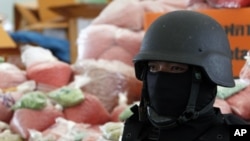The United Nations released a report Tuesday documenting a significant expansion of illicit drug manufacturing, trafficking and use in East and Southeast Asia.
The report from the U.N. Office on Drugs and Crime urges governments in the region to increase enforcement, prevention and treatment programs to contain the growing problem.
Gary Lewis, the U.N. Office of Drug and Crime regional representative for East Asia and the Pacific, said analysts are most concerned about the growing popularity of amphetamine-type stimulants, or ATS, drugs.
Drugs such as crystal meth and ecstasy are now among the top three drugs of use in the 15 east and southeast Asian countries they surveyed, said Lewis.
“We've seen a five fold increase in the number of ATS labs busted within the last four years or so, We've seen a four fold increase in the seized methamphetamine seizures over the past couple of years.”
The growth of the drugs varies across the region. Investigators say Australia, Japan, New Zealand, the Philippines and South Korea have reported stable or declining usage. But there are increasing numbers of users in Cambodia, China, Laos, Burma, Thailand and Vietnam.
The report also documents a staggering increase in methamphetamine seizures in the region, from 32 million pills in 2008 to 136 million in 2010, which reflects the expanding production of these illicit drugs. And it says that in Indonesia, crystal methamphetamine has overtaken cannabis to become the primary illegal drug of use.
Lewis said a growing population of young people, unaware of the danger of these drugs, is increasing demand. Transnational criminal syndicates are meeting the growing demand with increased supply manufactured in areas where enforcement is lax, he adds.
Regional authorities need to go after the heads of these organizations and other professionals benefiting from the drug trade, Lewis said.
“Looking not only at arresting the dealers but looking at the bigger kingpin operations that are required, taking out the facilitators who are in many respects are lawyers and accountants, IT specialists, experts in trade who have supported the ancillary services of the drug trafficking groups.”
The report also says that, in 2010, there was a 19 percent increase in drug-use related arrests, compared to the previous year.
Lewis advocates better treatment facilities to help drug users end their addiction and increased educational programs to teach young people the serious health risks associated with repeated drug use.






